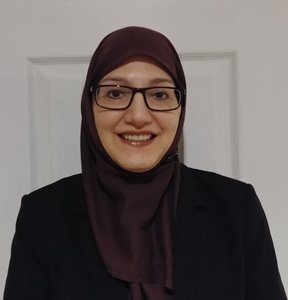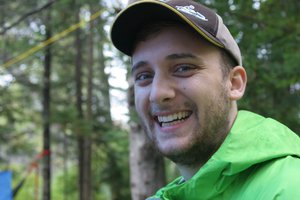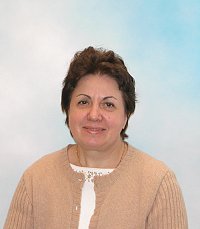Arrival
Hala Larizza-Ali
Undergraduate Coordinator

Hala is the new Undergraduate Coordinator, joining us from the Department of Economics where she served in interim roles as the Undergraduate Administrator and, most recently, the Graduate Assistant. Hala’s past roles include Undergraduate Administrator/Counselor for the Department of Economics at UTM, and the Department of Geography at the St. George campus.
Arrival
Andrea Leung
ATLAS Project Coordinator
Andrea Leung will be the ATLAS Project Coordinator. The ATLAS project is just beginning a new phase of instrument development that will involve the construction of a silicon detector that is made up of 1500 silicon detector modules incorporating silicon sensors and application specific integrated circuits mounted on hybrid flex circuits.The collaboration will include CERN, TRIUMF, 7 other universities, and custom manufacturing by several different suppliers. UofT is the Canadian centre for the project, and Andrea will be coordinating all of the different activities.
She comes from the Faculty of Medicine, where she worked as a facilities and lab manager.
Arrival
Michael Vansteenkiste
ATLAS Assembly Technician

Michael completed his Honors BSc in Physics at the University of Waterloo in 2020 where he focused his studies on applied physics. His co-op experiences focused on particle and nuclear physics and he spent time at TRIUMF and the National Research Council.
As an Assembly Technician, Michael is currently assisting with the preparation of the high energy physics laboratories for the pre-production phase of the ATLAS ITk project. In his day-to-day Michael assists with electronic and mechanical designs, testing of laboratory equipment and assuring Toronto meets manufacturing qualifications established by CERN.
In his spare time, Michael loves going hiking and canoeing. He has also recently picked up the hobby of adult gymnastics which he says has "been a very interesting and challenging adventure".
Departure
Ruxandra Serbanescu

‘And though she be but little, she is fierce’ – This description of Hermia in Shakespeare’s A Midsummer Night’s Dream is how Jeanette Pitre captures Ruxandra Serbanescu, and no one who knows Ruxandra could disagree. Students in her courses have described her as an amazing and caring professor, yet firm when necessary, and who “sets an example for the rest of the department”. Her colleagues are always impressed by her enthusiasm for teaching and her optimism that things will work out. "Let's do it!" is her catchphrase.
Ruxandra started her scientific career at the University of Bucharest where she received her M.Sc. and Ph.D for research in biological physics. Later she became an Assistant and then Associate Professor there, with much of her research focusing on the physics and chemistry of hemoglobin. After a stint at Université Paris-Sud XI, Ruxandra first came to the University of Toronto in 1997 as a Research Associate in the Department of Chemistry. She joined the Physics Department in 1998, first as Lecturer, then Senior Lecturer, and finally Associate Professor, Teaching Stream.
Ruxandra bridged the period where teaching-intensive faculty members moved from being ad hoc additions, to being fully recognized as integral and essential to the University’s undergraduate programs. She started out coordinating the laboratory sections associated with our huge first-year non-specialist physics courses, managing many dozens of Teaching Assistants and thousands of students. She then taught core lecture courses in both our Physics and Engineering Science programs, and coordinated our 200 and 300 level laboratory courses. She was a regular winner of both the Dean’s Merit and Excellence awards for her contributions.
When something new needed developing, Ruxandra was often in the lead.
We now have a robust Biological Physics research group, but in the early years of our biological physics programming, it was Ruxandra whom we depended on to provide relevant expertise. She was heavily involved in both the design of the courses and programming for our Biological Physics Specialist, and she was the go-to instructor for all our life science physics courses beyond first year, regularly teaching Physics of Living Systems and Introduction to Biological Physics.
Later, when the Department settled on Python as the standard computing language for our undergraduate program, Ruxandra took on the responsibility for developing PHY224 into the one course where we actually teach Python to students.
In recent years she has thought deeply about Physics Education, being an author on Physics Education Research papers such as “Putting computation on a par with experiments and theory” and “What’s all the Clicking About? A Study of Classroom Response System Use”. In “Threshold Concepts in Physics: Too many to count”, she reflected on how simply spending more time on some topics often doesn’t seem to help.
Ruxandra has always been a linchpin of the teaching focused faculty, organizing weekly lunches to keep us connected – something we have all missed over the last year. Every weekly reminder would come with optimistic – and often weather related - encouragement: “... Let's warm up with good food and a nice chat!”, “After all, it will be a balmy -12C at lunchtime”, …
Outside the department, Ruxandra loves skiing in the mountains, and is always proud of her family’s accomplishments and modest about her own. She will be missed.
Mulţumesc frumos, Ruxandra, a fost o plăcere să lucrăm împreună. La revedere!
By David Bailey, with input from Jason Harlow, Jeanette Pitre, John Pitre, and Brian Wilson
Departure
Ana Sousa
Mrs. Ana Sousa Retires as Administrative Assistant of the Earth, Atmospheric and Planetary Physics Group
Ana joined the EAPP Group, then the Atmospheric Physics Group, as Group Secretary on January 11, 1982, and has since served not only as a key member of the group but in many ways as the centre around which all of our activities have been organized. Prior to her joining us, it would be a considerable understatement to say that our organizational structure was somewhat “chaotic”. Those bad old days, some others might yet remember, were the pre-word processing days of typewriters and sno-paque white out. So Ana has been a colleague and friend to all members of our group, both students and faculty, for almost 40 years. Speaking for myself, one who has worked closely with Ana for all of this time, her departure from our daily lives is an event anticipated with more than a little trepidation.
I have been forced to accept this impending reality by a recent message from Peter Hurley requesting that I serve on an appointment committee to find a new EAPP Administrative Assistant. The first task was to consider what might be an appropriate job description. Of course HR has plug and play text with which all jobs are supposed to be describable; one only has to choose from among the extensive list of possible phrases. I noticed immediately that the four pages of possible descriptions did not contain any of the adjectives that have made Ana such an important member of the EAPP community, kindness and integrity being two of the characteristics which have made her so effective in her position. Other characteristics have also been crucial ingredients of her success, technical ability in processing the words and symbols, being one of these, but even more important has been her willingness to pitch-in with extra effort when unanticipated deadlines loomed, and always with good humor.
Among our activities there is one in which Ana has taken special pleasure, one in which she has been involved for more than 15 years. When the Centre for Global Change Science (CGCS) was first established by Faculty of Arts and Science in the early 2000’s, it included administrative support which has since been employed to cover a portion of Ana’s salary. She took immediately to the work involved in operation of the Centre as this required direct interaction with large numbers of undergraduate students as well as graduate students from multiple departments across the University who are affiliated with the CGCS. For all of these students Ana became the face of the Centre, the person to whom they turned, not only for information concerning our programs, but also for encouragement when this was required. Her advocacy for these students has been extremely important to the success of these programs. Again those qualities of kindness and integrity mentioned previously have helped immeasurably to ensure the continuing success of this important U of T activity in the area of climate and environmental science.
In her retirement Ana will be much missed by her friends and colleagues in the Earth, Atmospheric and Planetary Physics Group that she has so ably, and with such good humor, served for almost 40 years.
By Dick Peltier

